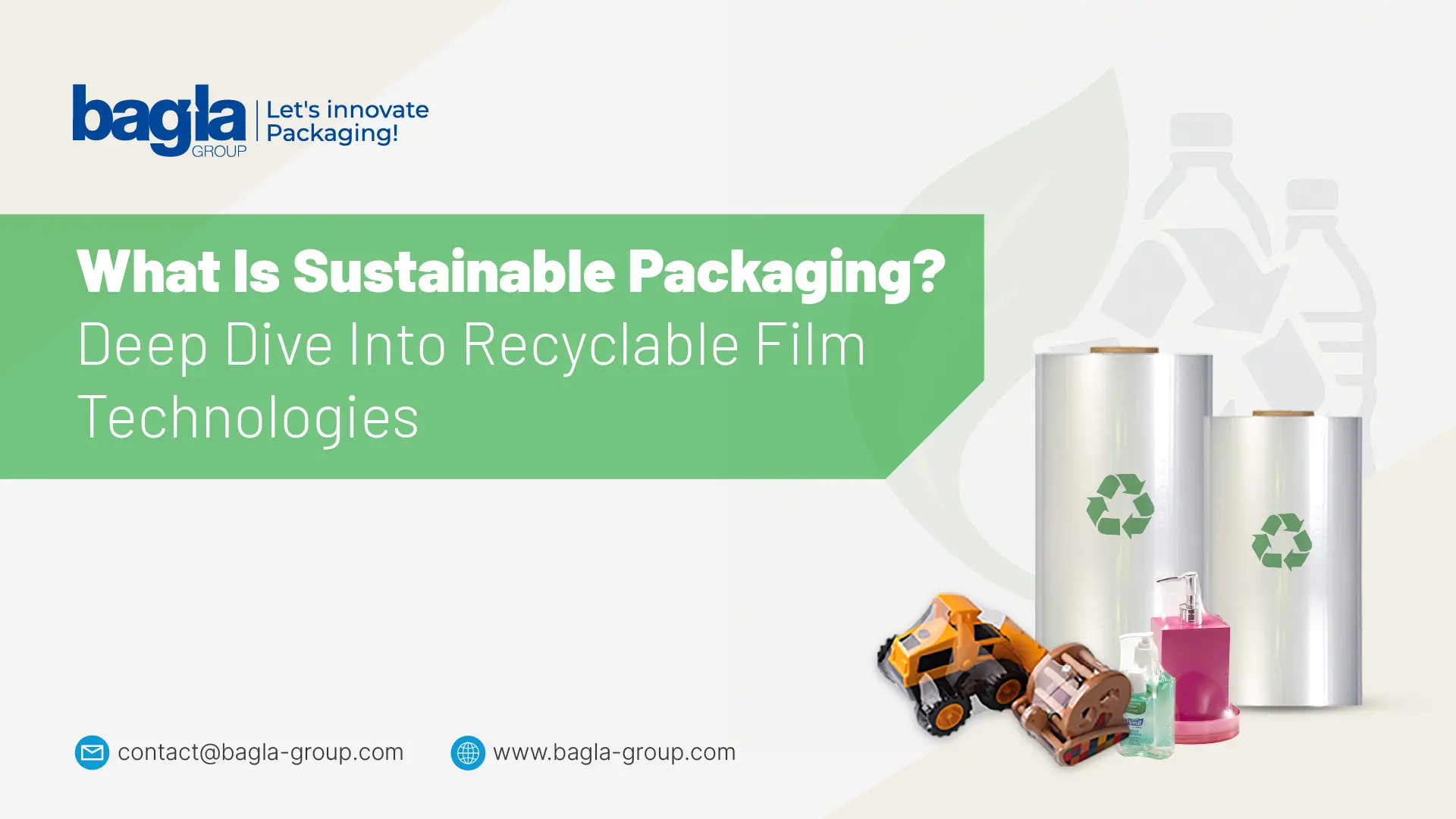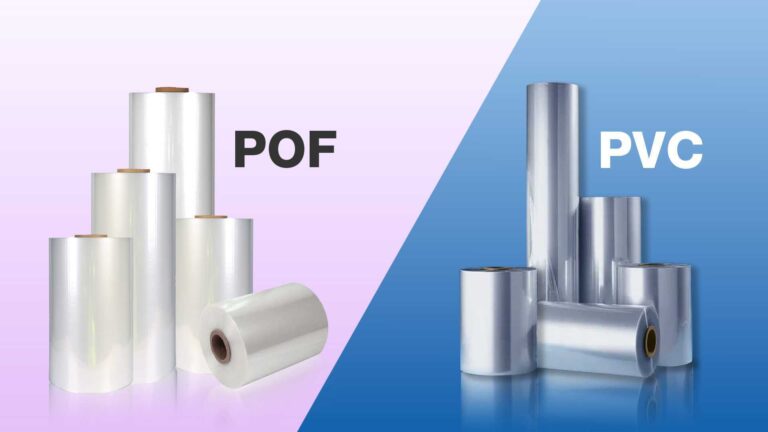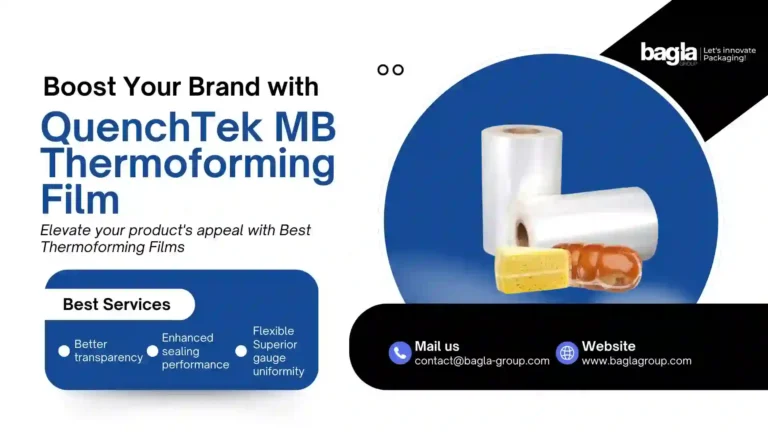As we all know, due to growing pollution, people are shifting towards an eco-conscious world. According to this, sustainability is no longer just a buzzword, it is mandatory. Consumers are very much aware of their environmental footprint. However, brands are being challenged to innovate not only the products but also how they package them. So, due to this concern, Sustainable packaging takes center stage. But have you ever thought what exactly sustainable packaging is and how recyclable film technologies play a role in its evolution?
This guide will help you explore the meaning of sustainable packaging, types of recyclable films, benefits, challenges, and why companies like Bagla Group are leading the way.
What Is Sustainable Packaging?
Sustainable packaging is a type of packaging that minimizes the environmental impact and ecological footprint throughout its lifecycle. The lifecycle of the packaging begins from sourcing and production to use and disposal. For sustainable packaging, packaging must meet one or more following criteria –
- Made from renewable, recycled, or biodegradable materials
- Designed for reuse, recyclability, or compostability
- Created using clean production technologies
- Engineered to minimize material and energy waste
In essence, it’s packaging that is safe, efficient, circular, and responsible.
Role of Recyclable Film Technologies in Sustainable Packaging
The recyclable film technologies are the most impactful innovation in sustainable packaging. These films are designed to reduce plastic waste and maintain durability, barrier protection, and shelf appeal required in modern packaging. Recyclable films are widely used in flexible packaging for industries such as food, personal care, pharmaceuticals, and industrial sectors.
Types of Recyclable Packaging Films
To innovate the sustainable packaging for a safe surrounding and a healthy environment, industries can simply choose recyclable packaging films as follows:
1. Mono-Material Polyethylene (PE) Films
These films are made entirely from polyethylene. PE films allow easy recycling without separation. One of the reliable options for the packaging of food pouches, shrink wraps, and liners. The benefits of using these films are Lightweight, compatible with recycling infrastructure, and high clarity.
2. Polypropylene (PP) Films
PP films are highly recyclable plastic with excellent moisture resistance and rigidity. Compatible for the packaging of Flow wraps, snack packs, and salad trays. The advantages of using these Polypropylene (PP) Films are Heat resistance, high stiffness, and food safety.
3. Paper Laminates with Recyclable Coatings
These films are a combination of papers with barrier layers like EVOH or water-based coatings. Use can simply apply these films on dry goods, coffee bags, and tea sachets. The benefits of using these films for sustainable packaging are compostable paper feel, and recyclable in paper streams.
4. Bio-Based and Compostable Films (e.g., PLA)
These bio-based films are derived from natural resources like corn starch or sugarcane. A user can simply implement this on the fresh produce, organic products. The benefits of using these films are industrially compostable and have renewable sourcing.
Note – Not suitable for regular plastic recycling streams.
Why Choose Recyclable Film Technologies?
Recyclable films make sustainable packaging more realistic and scalable for businesses. Here’s how –
- Environmental Impact Reduction – When you use the Recyclable films, they reduce landfill load, microplastic leakage, and CO₂ emissions, contributing to climate goals and a circular economy.
- Consumer Demand & Loyalty – Most of the new buyers in the market prefer eco-friendly packaging. So, when you use these films, they enhance the brand trust and influence purchase decisions.
- Regulatory Compliance – Many countries are now enforcing Extended Producer Responsibility (EPR) and plastic bans. Recyclable packaging ensures you’re compliant globally.
- Cost Savings Over Time – While initial investments may be higher, recyclable packaging leads to long-term savings via reduced waste, fewer penalties, and stronger brand loyalty.
Common Challenges in Recyclable Film Adoption
Despite its benefits, recyclable film packaging presents a few challenges –
- Barrier Performance Limitations – Mono-materials often have lower oxygen/water vapor protection than complex laminates.
- Heat Sealing Variations – Machines might need to be recalibrated for new film thicknesses or materials.
- Limited Collection Infrastructure – In many regions, flexible films are not accepted in curbside recycling.
- Consumer Confusion – Mislabeling or a lack of disposal education can reduce actual recycling rates.
Material Innovations Driving Sustainable Packaging Forward
The packaging industry is investing heavily in R&D to overcome these barriers –
- BOPE & MDO-PE Films – Offering clarity and durability with improved recyclability.
- Water-Based Inks & Adhesives – Reduce contamination during recycling.
- Recyclable Barrier Coatings – Replace aluminum and PVC in traditional laminates.
Why Bagla Group Is the Sustainable Option for You?
When selecting a partner for your sustainable packaging transition, Bagla Group delivers not just products but a forward-thinking commitment to green innovation.
- Expertise in Recyclable Films – Bagla Group is one of the global leaders offering POF shrink films and recyclable packaging options. These films are designed for performance, safety, and compliance with international recycling standards.
- Eco-Friendly Manufacturing – From scratch to final products, the Bagla Group team emphasizes energy-efficient processes and reduces plastic waste.
- Global Expansion with Sustainable Focus – With a new state-of-the-art manufacturing plant in Paraguay, Indonesia Bagla Group is expanding sustainably, supporting local economies and reducing carbon footprints through optimized supply chains.
- Custom Packaging Solutions – Whether you’re in food, FMCG, industrial, or pharma, Bagla Group develops tailor-made recyclable films that meet your exact product and shelf-life needs.
- Strong Compliance & Global Trust – Bagla films are aligned with frameworks like RecyClass, CEFLEX, and EPR compliance, ensuring your packaging stands up to global scrutiny.
Transitioning to Sustainable Packaging – What Brands Should Do
Switching to sustainable packaging isn’t just about changing materials, it’s about shifting mindsets and processes. Here’s a basic roadmap –
- Audit Current Packaging for recyclability, material use, and environmental impact.
- Consult with experts like Bagla Group to identify viable, sustainable alternatives.
- Test packaging prototypes for performance (seal, shelf-life, appeal).
- Label responsibly with clear disposal instructions and recycling logos.
- Educate consumers through campaigns, QR codes, or product stories.
Conclusion
If you are thinking that swapping from plastic to paper is a sustainable packaging option, then you might be wrong. Sustainable packaging requires thoughtful design, material innovation, and partnering with the right manufacturers. You can work with sustainable packaging with recyclable film technologies. These films play a central role, as these brands can reduce environmental harm without compromising on quality or shelf presence.
Is Sustainable Packaging Always Recyclable?
Recyclability is just one aspect, it may also be reusable, compostable, or made from renewable sources.
Can recyclable film packaging be used for food?
Yes, certain recyclable packaging films can be used in the food industry for packaging food items. It is widely used across snacks, frozen goods, and dry products.



